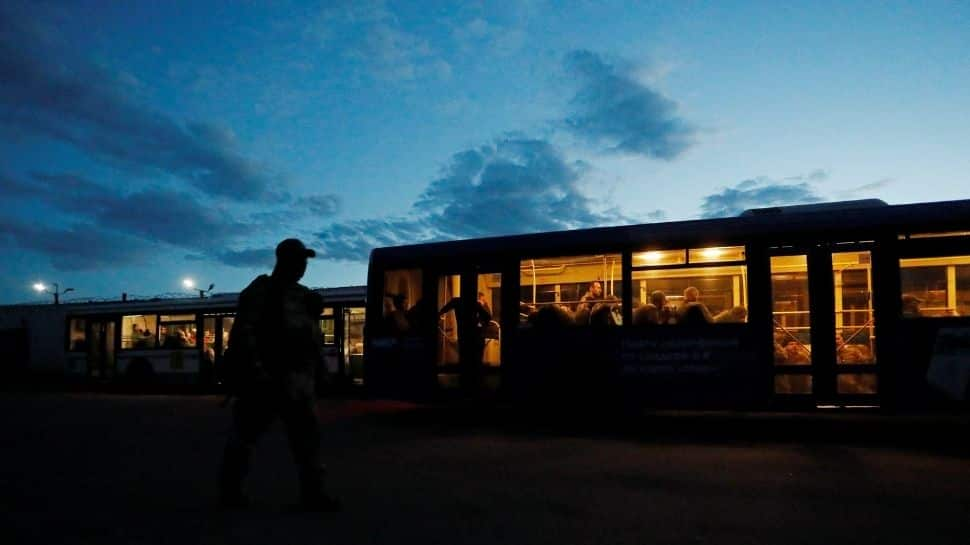Kyiv: Mariupol appeared on the verge of falling to the Russians on Tuesday (May 18) as Ukraine moved to abandon the steel plant where hundreds of its fighters had held out for months under relentless bombardment in the last bastion of resistance in the devastated city. The capture of Mariupol would make it the biggest city to be taken by Moscow’s forces and would give the Kremlin a badly needed victory, though the landscape has largely been reduced to rubble. More than 260 Ukrainian fighters “some of them seriously wounded and taken out on stretchers” left the ruins of the Azovstal plant on Monday and turned themselves over to the Russian side in a deal negotiated by the warring parties.
An additional seven buses carrying an unknown number of Ukrainian soldiers from the plant were seen arriving at a former penal colony Tuesday in the town of Olenivka, approximately 88 kilometers (55 miles) north of Mariupol. While Russia called it surrender, the Ukrainians avoided that word and instead said the plant’s garrison had successfully completed its mission to tie down Russian forces and was under new orders. “To save their lives. Ukraine needs them. This is the main thing,” Ukrainian Defense Minister Oleksiy Reznikov said.

Buses carrying service members of Ukrainian forces who have surrendered after weeks holed up at Azovstal steel works arrive in Olenivka (Pic: Reuters)
The Ukrainians expressed hope that the fighters would be exchanged for Russian prisoners of war. But Vyacheslav Volodin, speaker of the lower house of the Russian parliament, said without evidence that there were “war criminals” among the defenders and that they should not be exchanged but tried. Ukrainian President Volodymyr Zelenskyy said the country’s military and intelligence officers are still working to extract its remaining troops from the sprawling steel mill. Officials have not said how many remain inside. “The most influential international mediators are involved,” he said.
The operation to abandon the steel plant and its labyrinth of tunnels and bunkers signaled the beginning of the end of a nearly three-month siege that turned Mariupol into a worldwide symbol of both defiance and suffering. The Russian bombardment killed over 20,000 civilians, according to Ukraine, and left the remaining inhabitants “perhaps one-quarter of the southern port city’s prewar population of 430,000” with little food, water, heat or medicine.
During the siege, Russian forces launched lethal airstrikes on a maternity hospital and a theater where civilians had taken shelter. Close to 600 people may have been killed at the theater. Gaining full control of Mariupol would give Russia an unbroken land bridge to the Crimean Peninsula, which it seized from Ukraine in 2014, and deprive Ukraine of a vital port. It could also free up Russian forces to fight elsewhere in the Donbas, the eastern industrial heartland that the Kremlin is bent on capturing. And it would give Russia a victory after repeated setbacks on the battlefield and the diplomatic front, beginning with the abortive attempt to storm Kyiv, the capital.
The Russian victory, though, is mostly a symbolic boost for Russian President Vladimir Putin than a military win, said retired French Vice Adm. Michel Olhagaray, a former head of France’s center for higher military studies. He said: “Factually, Mariupol had already fallen.”
“Now Putin can claim a victory’ in the Donbas,” Olhagaray said. But because the Azovstal defenders’ ‘incredible resistance’ tied down Russian troops, Ukraine can also claim that it came out on top. “Both sides will be able take pride or boast about a victory, victories of different kinds,” he said.
Ukrainian presidential adviser Mykhailo Podolyak likened the Ukrainian defenders to the vastly outnumbered Spartans who held out against Persian forces in ancient Greece. “83 days of Mariupol defense will go down in history as the Thermopylae of the XXI century,” he tweeted.
The soldiers who left the plant were searched by Russian troops, loaded onto buses accompanied by Russian military vehicles, and taken to two towns controlled by Moscow-backed separatists. More than 50 of the fighters were seriously wounded, according to both sides.
It was impossible to confirm the total number of fighters brought to Olenivka or their legal status. While both Mariupol and Olenivka are officially part of Ukraine’s eastern Donetsk region, Olenivka has been controlled by Russia-backed separatists since 2014 and forms part of the unrecognized ‘Donetsk People’s Republic.’ Prior to the rebel takeover, penal colony No. 120 had been a high-security facility designed to hold those sentenced for serious crimes.
Footage shot by The Associated Press shows the convoy was escorted by military vehicles bearing the pro-Kremlin ‘Z’ sign, as Soviet flags fluttered from poles along the road. About two dozen Ukrainian fighters were seen in one of the buses. Ukraine’s human rights ombudsman said the Russian military was holding more than 3,000 civilians from Mariupol at another former penal colony near Olenivka. Ombudsman Lyudmyla Denisova said most civilians are held for a month, but those considered “particularly unreliable,” including former soldiers and police, are held for two months. The detainees include about 30 volunteers who delivered humanitarian supplies to Mariupol while it was under siege, she said.






